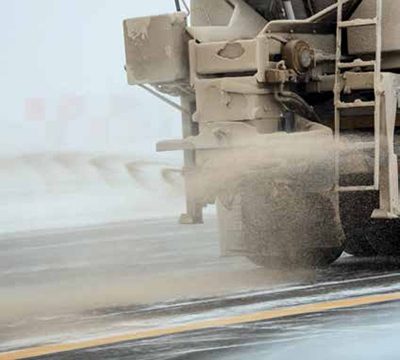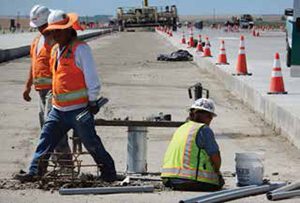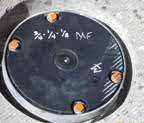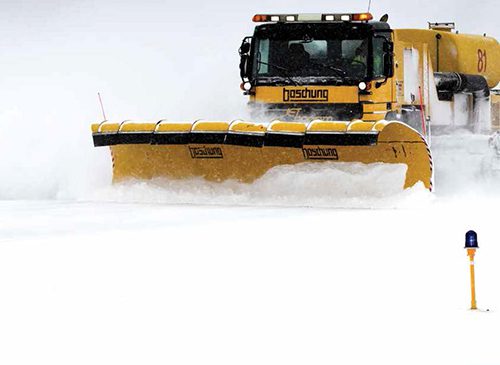Denver International Airport (DEN) has a new tool at its disposal for managing winter operations: in-pavement sensors that help predict when ice will form on runway and other airfield surfaces.
The system includes five clusters of sensors embedded in Runway 17L-35R, one of DEN’s four north/south runways, and three more clusters in adjacent high-speed taxiways. The in-pavement sensors were installed as part of a $46.5 million runway resurfacing project.
 facts&figures facts&figuresProject: Ice Warning System Location: Denver Int’l Airport Runway: 17L-35R (& associated taxiways) Timeline: Installed during $46.5 million runway reconstruction Funding: Airport Improvement Program grants; airport funds Project Completed: Oct. 2015 Approx. Cost of Ice Warning System: $274,000 System Manufacturer: Airport Surface Friction Tester Distributor: American Safety Technologies Runway Contractor: Flatiron Construction Electrical & Mechanical Component Installation: Sturgeon Electric Liquid Deicer Used: 616,452 gallons of potassium acetate during 2014-2015 winter Avg. Spent on Deicing Chemicals: $2.72 million/yr (during last 4 yrs) Of Note: Active sensors determine the freezing point of runway precipitation (vs. simply the surface temperature of pavements) Key Benefit: System is designed to reduce unnecessary application of deicing agents |
The new system, which cost about $274,000, will help personnel monitor icing conditions more effectively and allow them to better manage the deicing agents they use on airfield pavements, explains Mike Carlson, DEN’s assistant director of airside operations. By providing more accurate warnings about when icy conditions will develop, the system is expected to reduce airfield maintenance expenditures and minimize the number of runway closures required for pavement deicing.
Airport Surface Friction Tester (ASFT), a company based in icy Sweden, designed and manufactures the equipment.
DEN’s new system came online in October, just as the local snow season began. As such, it’s still too soon to determine how much the airport will save by reducing unnecessary applications of potassium acetate deicing solution.
“Based on discussions I’ve had at winter ops conferences with colleagues from other airports, they’re seeing significant savings,” Carlson reports. “At $4 to $5 a gallon for deicer, those numbers add up quickly. So this is definitely a better way to go. Our plan is to base our tactical decisions regarding liquid/chemical applications on information this system provides us.”
Multiple Advantages
Safety and airfield efficiency were also key considerations. “If we don’t have to get out on the runway to conduct a pavement friction assessment, we stay out of the way and are able to land that many more aircraft,” Carlson explains. “In the long run, it saves airlines money, too, and helps them maintain their on-time performance as much as possible during a snow event. We can let the runway be until the surface temperature (of the runway) and the freezing point get close enough that we actually have to get out there and do some remediation.”
Jeanne Lindberg, business development director for the system’s Canadian and U.S. distributor, notes that ASFT developed the sensors to help airfield crews spread less deicer, but still maintain extremely safe conditions. DEN is the first U.S. airport to use the system.
“Airports using this system in 15 countries around the world have reduced pavement deicer use by up to 30%,” reports Lindberg. “So if an airport spends millions of dollars on deicer every year, that 30% reduction is definitely significant.”
Lindberg points to Heathrow Airport as a specific example. According to its winter operations director, the London facility saved about $400,000 by applying less deicer in two storms alone.
Carlson explains the potential savings for DEN this way: “If we know the surface won’t freeze until it reaches a lower temperature, then we won’t put down an additional layer of pavement chemicals when we go out to remove snow from a runway. It will save us money, and using less chemicals is better for the environment, too.”
Typically, DEN receives about 58 inches of snow per winter season (generally October through April). During the last four winter seasons, crews applied an average of 605,500 gallons of potassium acetate deicer. At an average cost of $4.50 per gallon, the airport spent approximately $2.72 million per season on deicing agents.
DEN spokesman Heath Montgomery notes that the four-season period cited includes an outlier winter that drove up costs. During the 2012-2013 season, the area received 20 more inches of snow than usual, and the airport used 925,669 gallons of pavement deicing chemicals.
Timing is Everything
The renovation of Runway 17L-35R provided DEN with the opportunity to replace its less-advanced ice monitoring system without extra disruption to the fifth-busiest U.S. airport. In 2014, DEN served 53.4 million passengers.
Flatiron Construction won the $35.3 million contract to replace more than 2,000 deteriorating concrete slabs. DEN funded the project with airline fees and about $20 million from the FAA Airport Improvement Program.
The airport’s previous system, which used passive sensors, reported only runway pavement temperatures. “Leading up to a storm, we’d watch the passive sensors and spread the liquid chemical when the pavement got close to 32 degrees, to lower the freezing point of the surface,” Carlson explains. “Then, after that first application, we’d go out and put more chemicals down during snow removal operations. But we based that decision on just the surface temp alone.”
 The shortcoming of DEN’s former system was that the freeze point of melting snow that is mixed with liquid chemicals often drops, which negates the need to spread more deicer. Prior to installing the new ice warning system, airfield personnel had to make maintenance decisions based on surface temperatures alone, because the sensors couldn’t measure the freezing point of precipitation, Carlson explains.
The shortcoming of DEN’s former system was that the freeze point of melting snow that is mixed with liquid chemicals often drops, which negates the need to spread more deicer. Prior to installing the new ice warning system, airfield personnel had to make maintenance decisions based on surface temperatures alone, because the sensors couldn’t measure the freezing point of precipitation, Carlson explains.
“Most people think rain and sleet will freeze at 32 degrees,” Lindberg adds. “But even if the surface temperature of the runway is below freezing, the actual freezing point of the precipitation may be lower than the surface temperature of the runway because of the pavement deicers. So at that point, the runway won’t freeze as long as the freezing point (of the precipitation) is lower than the surface temperature of the runway.”
Eventually, deicing agents become diluted by precipitation or get dispersed as airplanes land and takeoff. That’s when the precipitation’s freezing point will rise and approach the level of the surface temperature.
 Differentials Make the Difference
Differentials Make the Difference
DEN’s new system includes two types of sensors: surface state sensors to measure the surface temperature of airfield pavements, and active freezing point sensors, which determine the freezing point of runway precipitation. Each of the eight clusters includes three active sensors and one passive sensor. The active sensors help determine the critical times when the freezing point of precipitation on the runway is close to the surface temperature, which is when more deicer is required, Lindberg relates.
“If the surface temperature is 29 degrees, for example, and the freezing point of the precipitation is 28, you know you’re at high risk for the runway to freeze,” she explains. “The time to really keep an eye on it is when there’s about a five-degree difference.”
How does the system determine that crucial temperature differential? The active sensors contain a peletier element, which lowers the temperature on the sensor until the precipitation on top of it freezes. This allows the system to provide a freezing-point reading. According to ASFT, the sensors obtain readings in about 20 to 40 seconds. The measurement devices are also very precise, adds Lindberg, noting that the active sensors are accurate to within plus or minus 0.4 of a degree.
 DEN followed ASFT’s recommendations and installed sensor clusters at the takeoff, midpoint and touchdown portions of the runway. Another was installed halfway between the takeoff area and midpoint, and one is stationed between the midpoint and touchdown area. All were embedded to be flush with the runway surface.
DEN followed ASFT’s recommendations and installed sensor clusters at the takeoff, midpoint and touchdown portions of the runway. Another was installed halfway between the takeoff area and midpoint, and one is stationed between the midpoint and touchdown area. All were embedded to be flush with the runway surface.
Each of the sensors is hardwired to one of four general processing units (GPUs), located alongside the runway. “The GPU analyzes the data and sends it wirelessly to a secure server, where approved airport personnel can view the data online,” comments Lindberg.
The system is designed to automatically send email alerts based on the data it gathers, according to users’ preferences. At DEN, snow ops personnel receive tiered messages: advisory emails when the difference between surface temperatures and the precipitation freezing point is 11 degrees, freeze watch alerts when the differential reaches seven degrees, and freeze warning alerts when it’s four degrees. “You can create as many rules (for alerts) as you want, but those are the ones we’re keying in on right now,” Carlson notes.
In January, DEN personnel were still busy tweaking and familiarizing themselves with the new system — a process ASFT engineers assure them is normal. The manufacturer advised DEN officials that it typically takes a full snow season to get the system dialed in and calibrated correctly.
“We need to train ourselves to trust the numbers and base our tactical decisions on them,” Carlson reflects. “Our goal is to build a data base, so that when we do significant rehabilitation of other runways in the future, we already have a case made for installing more of these sensors.”





